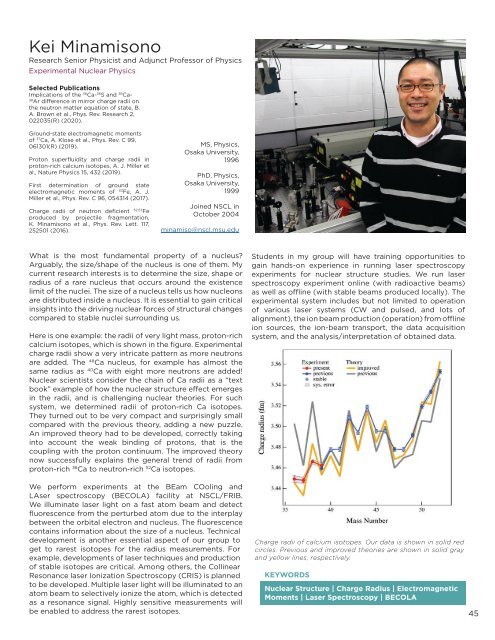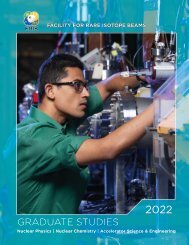2021FRIB/NSCL Graduate Brochure
Create successful ePaper yourself
Turn your PDF publications into a flip-book with our unique Google optimized e-Paper software.
Kei Minamisono<br />
Research Senior Physicist and Adjunct Professor of Physics<br />
Experimental Nuclear Physics<br />
Selected Publications<br />
Implications of the 36 Ca- 36 S and 38 Ca-<br />
38<br />
Ar difference in mirror charge radii on<br />
the neutron matter equation of state, B.<br />
A. Brown et al., Phys. Rev. Research 2,<br />
022035(R) (2020).<br />
Ground-state electromagnetic moments<br />
of 37 Ca, A. Klose et al., Phys. Rev. C 99,<br />
061301(R) (2019).<br />
Proton superfluidity and charge radii in<br />
proton-rich calcium isotopes, A. J. Miller et<br />
al., Nature Physics 15, 432 (2019).<br />
First determination of ground state<br />
electromagnetic moments of 53 Fe, A. J.<br />
Miller et al., Phys. Rev. C 96, 054314 (2017).<br />
Charge radii of neutron deficient 52,53 Fe<br />
produced by projectile fragmentation,<br />
K. Minamisono et al., Phys. Rev. Lett. 117,<br />
252501 (2016).<br />
MS, Physics,<br />
Osaka University,<br />
1996<br />
PhD, Physics,<br />
Osaka University,<br />
1999<br />
Joined <strong>NSCL</strong> in<br />
October 2004<br />
minamiso@nscl.msu.edu<br />
What is the most fundamental property of a nucleus?<br />
Arguably, the size/shape of the nucleus is one of them. My<br />
current research interests is to determine the size, shape or<br />
radius of a rare nucleus that occurs around the existence<br />
limit of the nuclei. The size of a nucleus tells us how nucleons<br />
are distributed inside a nucleus. It is essential to gain critical<br />
insights into the driving nuclear forces of structural changes<br />
compared to stable nuclei surrounding us.<br />
Here is one example: the radii of very light mass, proton-rich<br />
calcium isotopes, which is shown in the figure. Experimental<br />
charge radii show a very intricate pattern as more neutrons<br />
are added. The 48 Ca nucleus, for example has almost the<br />
same radius as 40 Ca with eight more neutrons are added!<br />
Nuclear scientists consider the chain of Ca radii as a “text<br />
book” example of how the nuclear structure effect emerges<br />
in the radii, and is challenging nuclear theories. For such<br />
system, we determined radii of proton-rich Ca isotopes.<br />
They turned out to be very compact and surprisingly small<br />
compared with the previous theory, adding a new puzzle.<br />
An improved theory had to be developed, correctly taking<br />
into account the weak binding of protons, that is the<br />
coupling with the proton continuum. The improved theory<br />
now successfully explains the general trend of radii from<br />
proton-rich 36 Ca to neutron-rich 52 Ca isotopes.<br />
We perform experiments at the BEam COoling and<br />
LAser spectroscopy (BECOLA) facility at <strong>NSCL</strong>/FRIB.<br />
We illuminate laser light on a fast atom beam and detect<br />
fluorescence from the perturbed atom due to the interplay<br />
between the orbital electron and nucleus. The fluorescence<br />
contains information about the size of a nucleus. Technical<br />
development is another essential aspect of our group to<br />
get to rarest isotopes for the radius measurements. For<br />
example, developments of laser techniques and production<br />
of stable isotopes are critical. Among others, the Collinear<br />
Resonance laser Ionization Spectroscopy (CRIS) is planned<br />
to be developed. Multiple laser light will be illuminated to an<br />
atom beam to selectively ionize the atom, which is detected<br />
as a resonance signal. Highly sensitive measurements will<br />
be enabled to address the rarest isotopes.<br />
Students in my group will have training opportunities to<br />
gain hands-on experience in running laser spectroscopy<br />
experiments for nuclear structure studies. We run laser<br />
spectroscopy experiment online (with radioactive beams)<br />
as well as offline (with stable beams produced locally). The<br />
experimental system includes but not limited to operation<br />
of various laser systems (CW and pulsed, and lots of<br />
alignment), the ion beam production (operation) from offline<br />
ion sources, the ion-beam transport, the data acquisition<br />
system, and the analysis/interpretation of obtained data.<br />
Charge radii of calcium isotopes. Our data is shown in solid red<br />
circles. Previous and improved theories are shown in solid gray<br />
and yellow lines, respectively.<br />
KEYWORDS<br />
Nuclear Structure | Charge Radius | Electromagnetic<br />
Moments | Laser Spectroscopy | BECOLA<br />
45






